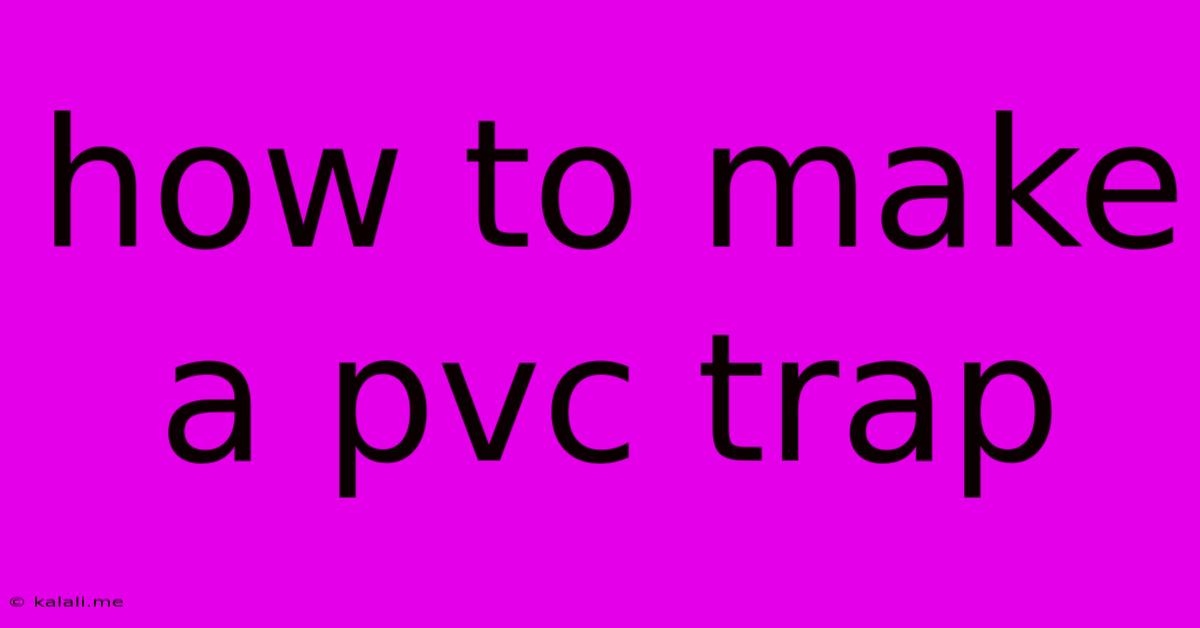How To Make A Pvc Trap
Kalali
Jun 01, 2025 · 3 min read

Table of Contents
How to Make a PVC Trap: A Comprehensive Guide for Beginners
This article will guide you through the process of building a simple and effective PVC trap, perfect for catching small critters like rodents or insects. We'll cover the materials you'll need, the steps involved, and some helpful tips for success. This DIY project is relatively inexpensive and can be a valuable tool for pest control around your home or garden.
What is a PVC trap and why use one? A PVC trap is a humane and reusable alternative to commercial traps. It's made using readily available PVC pipes and fittings, offering a cost-effective solution for managing pest populations. This method is particularly useful for those seeking environmentally friendly pest control options.
Materials You'll Need:
- PVC Pipes: Choose a diameter appropriate for the target pest. 2-inch or 3-inch pipes are commonly used. You'll need several short lengths to create the trap's structure.
- PVC Elbows (90°): At least two elbows are required, one for the entrance and one for the exit.
- PVC Tees: At least one tee is required to create the catching chamber.
- PVC End Caps: One or two end caps, depending on your design.
- PVC Cement: This is essential for securely joining the PVC pieces. Ensure it's compatible with your chosen PVC type.
- Primer (Optional but Recommended): Using primer with PVC cement enhances the bond's strength and longevity.
- Bait: Choose a bait that attracts your target pest. Peanut butter, grains, or fruit can be effective.
Step-by-Step Instructions:
-
Planning and Measurement: Before cutting any pipes, sketch out your desired trap design. This will help ensure accurate cutting and assembly. Measure carefully to avoid wasting material.
-
Cutting the Pipes: Use a PVC pipe cutter or a hacksaw to cut the pipes to your specified lengths. Ensure clean, straight cuts for a secure fit.
-
Applying Primer and Cement: Apply a thin layer of PVC primer to the ends of the pipes that will be joined. Then apply PVC cement to both the pipe ends and the inside of the fittings. Work quickly as PVC cement sets rapidly.
-
Assembling the Trap: Carefully join the PVC pipes and fittings according to your design. Make sure the connections are secure and properly aligned.
-
Adding the Bait: Once the cement has fully dried (usually about 30 minutes), place your chosen bait inside the catching chamber of the trap.
-
Setting the Trap: Position the trap in an area where the target pest is likely to be active. Ensure the trap is stable and easily accessible for checking and cleaning.
Design Variations:
Several design variations exist for PVC traps, each suited to different pests and situations. Some popular designs include:
- Simple Funnel Trap: This design uses a funnel-like structure to guide the pest into a catching chamber.
- Multiple-Chamber Trap: This design can hold more pests and prevent escape.
- Elevated Trap: Elevating the trap can help prevent larger animals from accessing it.
Tips for Success:
- Cleanliness: Keep the trap clean to avoid attracting unwanted insects or creating unpleasant smells.
- Bait Placement: Experiment with different bait types to determine what works best for your target pest.
- Location: Place the trap strategically in areas where pest activity is high.
- Regular Checking: Check the trap regularly to empty it and replenish the bait.
Building a PVC trap is a rewarding DIY project. This guide provides a solid foundation; feel free to experiment and adapt the design to your specific needs. Remember to prioritize safety when handling tools and working with chemicals. Happy trapping!
Latest Posts
Latest Posts
-
Does Dawn Dish Soap Kill Grass
Jun 03, 2025
-
Mtg Do Tokens Go To The Graveyard
Jun 03, 2025
-
Linux How To Add A User
Jun 03, 2025
-
Why Did My Sink Suddenly Stopped Working
Jun 03, 2025
-
How To Test A Switch With A Multimeter
Jun 03, 2025
Related Post
Thank you for visiting our website which covers about How To Make A Pvc Trap . We hope the information provided has been useful to you. Feel free to contact us if you have any questions or need further assistance. See you next time and don't miss to bookmark.